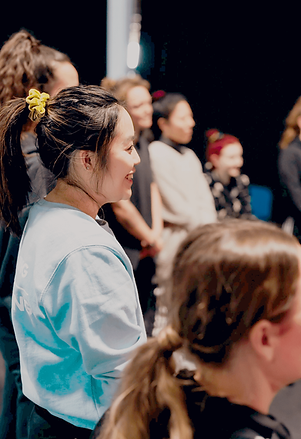Overcoming Back Pain: Pelvic Stability and Core Care for Dancers
- Beth Shum
- Jun 2
- 3 min read
Back pain is one of the most common musculoskeletal issues affecting people today, with 1 in 4 individuals experiencing it at some point in their lives. Whether you're a dancer, aerialist, circus artist, or someone simply trying to stay active, back pain can be frustratingly complex and often interferes with performance and daily life.
In this post, we’ll walk you through how to better understand your back pain and offer progressive core exercises you can try at home to build stability and regain control.

🧠 Why Back Pain Happens
Back pain doesn’t usually have just one cause. We know that multiple biopsychosocial factors can influence it:
Core weakness
Lack of mobility
Poor sleep
Stress and emotional tension
Deconditioning (not moving enough)
Thoughts and beliefs about pain itself
Sometimes it's hard to focus on things we can't control, but what we can control is our movement practice !!
That’s why strengthening the core is a good place to start—it helps support the spine, reduce pressure, and prevent flare-ups when doing more dynamic activities like dancing, running, or performing acrobatics.

🦴 Understanding the Spine
Let’s get anatomical for a second.
Article content
Your spine is divided into:
Cervical spine (neck)
Thoracic spine (mid-back)
Lumbar spine (lower back)
The lumbar region, where most back pain occurs, can take a lot of load. It requires a good range of motion and muscular stability to function properly. Your “core” isn’t just your abs—it includes:
Muscles of the lower back
Deep abdominal muscles
Diaphragm
Pelvic floor
All of these work together to support spinal health and movement.
💪 Start Here: Core Stability Progression for Low Back Pain
These exercises de-load the spine, making them safer to try even when you’re in pain.
1. Diaphragmatic Breathing
Lie on your back with your hands on your belly.
Breathe into your stomach—imagine expanding your ribs sideways and into your back.
This resets tension and activates your deep core muscles.
Why it helps: Brings awareness to your breath and calms the nervous system.
2. Pelvic Tilts
Still lying on your back:
Tilt your pelvis so your lower back presses gently into the mat
Then arch slightly away. Repeat several times, like a Cat-Cow, but on your back.
3. Tabletop Leg Floats
Bring one leg up to the tabletop (90°)
Lower and lift slowly, alternating sides
When ready, try both legs up together
Progression: Drop one leg at a time (alternate leg drops) while keeping your back pressed down.
4. Double Leg Pull-Ins
Bring both knees to your chest, pull in with control, and return
Focus on using your lower abs to stabilise
5. Leg Drops and Crunch Variations
Try heel taps or double-leg lowers
If you're advanced: extend legs straight and control the descent
Bonus challenge: reach arms overhead and return, keeping core engaged
🧘 Tips for Success:
Breathe with control: Exhale on effort, inhale on return
Avoid compensation: If your ribs lift off the mat, regress the movement
Pain ≠ progress: You should feel effort, not pain
Stay consistent: Core strength builds over time
📝 Final Thoughts
Whether you're a performer prepping for the stage or someone managing daily back discomfort, building core control is a powerful way to reduce pain and boost function. Start gently, focus on awareness, and progress with patience.
If you try these and still feel stuck, reach out to our physiotherapist for tailored guidance.
🔁 Feel free to share this with a friend who’s been battling back pain—or tag us with your progress @flexibility_matters.




.png)





Comments